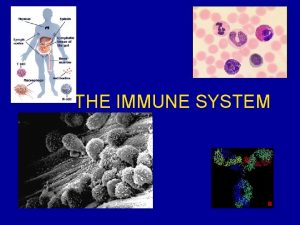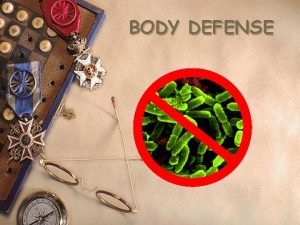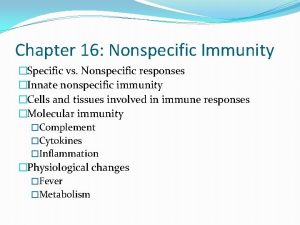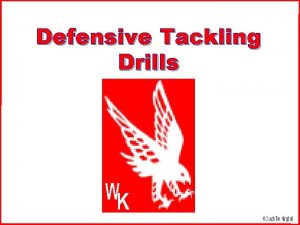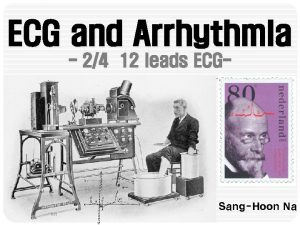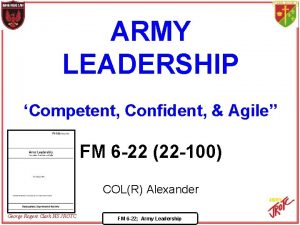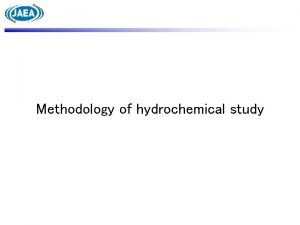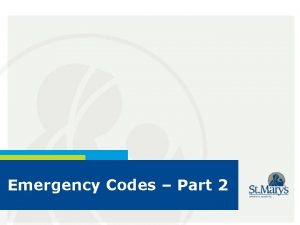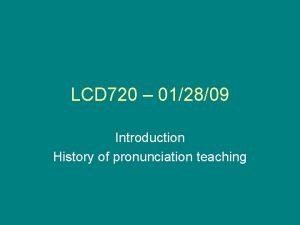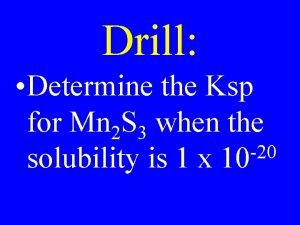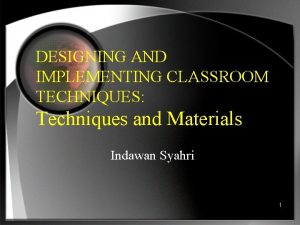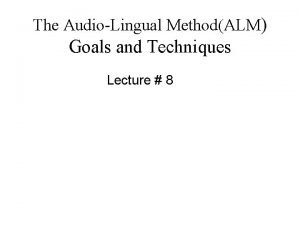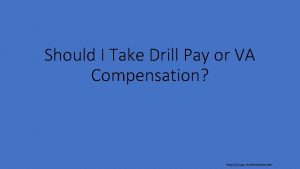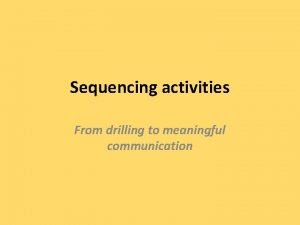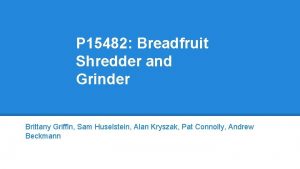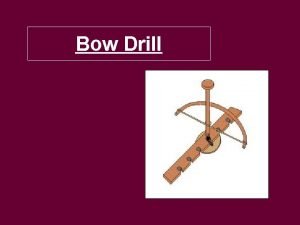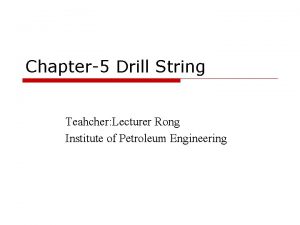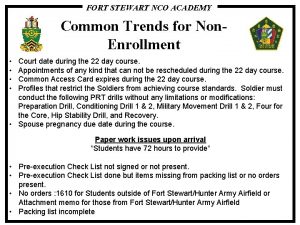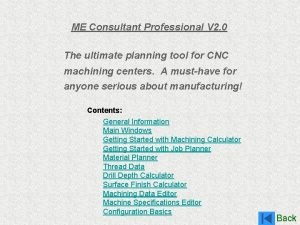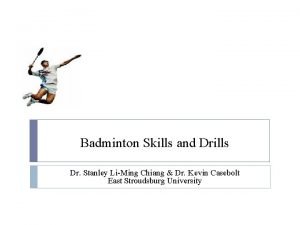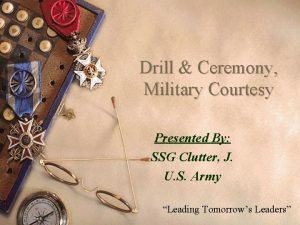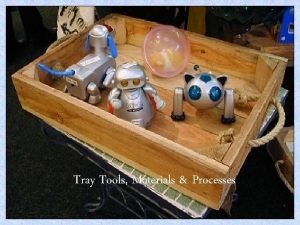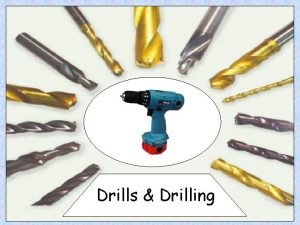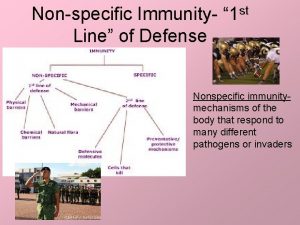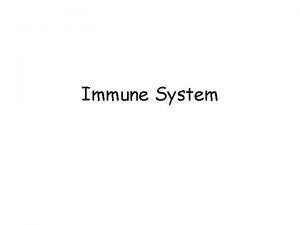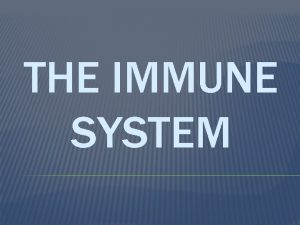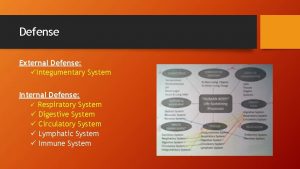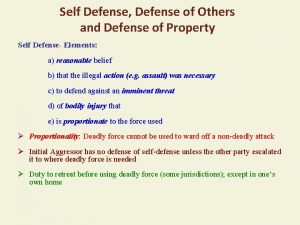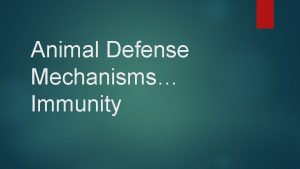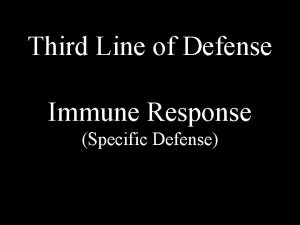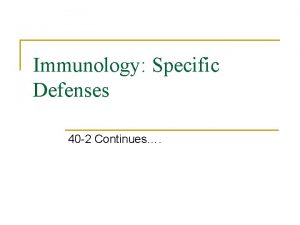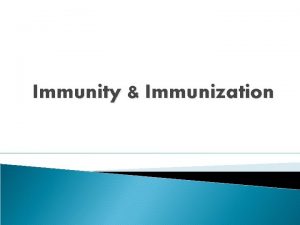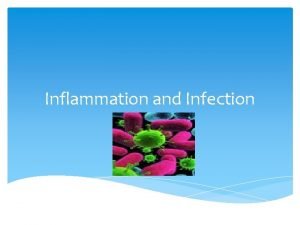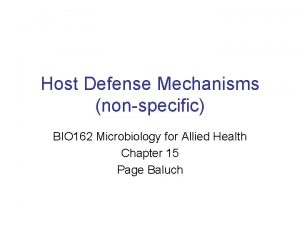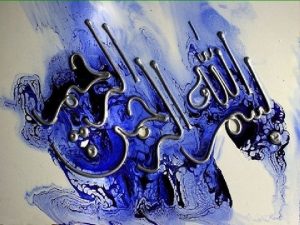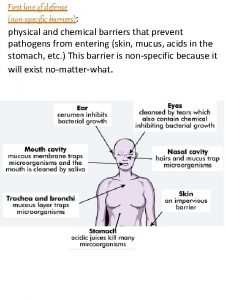Drill How is specific defense different from nonspecific












































- Slides: 44

Drill Ø How is specific defense different from nonspecific defense? Ø What cell is needed to activate both defenses? Ø What cells are produced from the T cell line? What cells are produced from the B cell line? Ø Which cell type is needed to activate the B cell line?

Drill Ø What is the difference between specific and non-specific response? Objective(s) Ø Types of non specific response. Ø Brain dissection Ø

Drill Ø Explain the difference between a non specific response and a specific response. State 2 non specific responses. Objective(s) Ø Types of specific response. Ø Brain dissection Ø

Drill Ø What is the purpose of antibodies? Ø How are the constant and variable regions on antibodies different? Ø Which region from above attaches to the antibodies? Objective(s) Explain the cell mediated response

Drill Ø Name the 2 types of lymphocytes and their location of development. Where are they stored after their development? Objective(S). Describe how antibodies are produced and time frame of production. Ø List and describe the diseases of the lymphatic system.

Ø How is natural immunity different from artificial immunity? Ø How is active immunity different from passive immunity?

Lymphatic System

I. Lymphatic Network A. Functions 1. _________- Transport lost fluid (lymph) back to the circulatory system. 2. _________ the body against pathogens. 3. ______absorption.

B. Lymphatic Capillaries 1. Microscopic _______ found between cells. (Not found in the brain, spinal cord, bone, epidermis) 2. Similar to _______. 3. _______ Joined endothelial cells C. Lymphatic Vessels 1. _______ three layers D. Lymph Nodes

Review Ø Name the functions of the lymphatic system. Ø State why lymphatic vessels are similar to veins.

E. Lymphatic Trunks & Collecting Ducts 1. _______ – merging vessels. 2. _______ – One duct before returning back to the heart. a. _______ – left side of the head, neck, thorax, left arm, entire lower body. 1. Empties into ____ subclavin 2. Originates from _______. b. _______ Duct – Right side of the head, neck, right arm 1. Empties into _______ subclavin

F. Lymph Movement 1. Formation – Interstitial fluid formed by movement of blood plasma out of the capillary bed. a. Increased interstitial fluid, ______________ forces lymph pores open – fluid flows ______. 2. Movement a. Force of interstitial fluid entering vessel b. Similar to veins: 1. _______ 2. _______ Skeletal movement.

Review Ø How is a lymphatic trunk different from a lymphatic duct. Ø Which ducts drain the right side of the body? Ø Which ducts drain the left half of the body?

II. Lymphatic Organs A. True organs 1. _______ tissue containing lymphocytes (white blood cells) B. Lymph Node 1. ____ – neck 2. _______ – armpit 3. ____ – groin 4. Deep with in C. Structure 1. _______ Vessels – Towards. 2. _____- Concave margin 3. _______ Vessels – Away. 4. _______ 5. _______ - Outer 6. _______ – Inner 7. _______ -Extensions 8. _______ – Main structure of lymph nodes, gathering of WBC

D. Node Function 1. _______ E. Spleen 1. _____ lymphatic organ 2. ________– outer, protection 3. _______– Large number of red blood cells. 4. _______– Large number of white blood cells. F. Thymus 1. _______ active during immune response. 2. _______production 3. Capsule 4. Cortex 5. Medulla G. Tonsils 1. Two _______ – Back of palate 2. Two _______al –Upper throat 3. Two _______ – Base of tongue H. Peyer’s Patches 1. _______ located along the _______

Review Ø What determines a true lymphatic organ? Ø What do true lymphatic organs contains? Ø What is the largest lymphatic organ of the body?

III. Defense Mechanisms A. Immune system has ability to _______foreign particles (pathogens &/or toxins). B. ______________ (MHC) – markers that can distinguish between self & non self. C. Two types of defense. 1. _______(innate) 2. _______ (adaptive) D. Type of responses 1. _______

Review Ø What are the two types of immune responses? Ø What determines is you will have a immune response?

E. Innate or Non Specific Mechanisms – Defends against all types of pathogens & has the same response. 1. _______ a. _______ b. _______ membranes 2. _______– Cellular Eating a. Monocytes b. Neutrophils c. Macrophages d. Natural Killer Cells Punches holes in cells. e. Swelling Basophils Mast cells Eosinophils

3. _______ Mediators a. _______ 1. _______ proteins 2. Helps enhance phagocytes b. _______ 1. Secreted by _______ cells to stimulate neighboring cells to produce antibodies.

4. Inflammation a. _______ - chemical attraction of phagocytes -_______ permeability b. _______inflammation c. _____ inflammation

Review Ø How is a non specific response differ from a specific response? Ø What are the four types of non specific responses?

F. Specific Mechanisms – ______________ 1. Ability to _______a specific antigen or toxin. a. Antigen recognition b. Proliferation 2. Components of Immunity a. _______ – any substance that causes an immune response. b. ____ (Ab) (gamma globulins or immunoglobulins)– protein molecule that is produced in response to a specific antigen. - ____heavy chains - ____ light chains c. AB + Antigen = Antigen-Ab complex (inactivation)

d. Five Classes of Ab 1. ____ – Most common - small 2. ___ – protection on body surfaces 3. ____ – First to be produced – large 4. ____ – Antigen-antibody receptors 5. ____ – Allergies (bind to mast cells) e. _______– made for specific antigens f. ____ – same between all antibodies

Specific Defense

e. _______ – come bone marrow 1. _______– develop in bone marrow a. _______ b. _______ – AB 2. _______– develop in thymus a. _______– destroy’s infected cell b. _______– stimulates immune system c. _______– stops the body’s response d. _______– remembers for future infections

Review What is a antigen? What is a antibody? How does the body recognize foreign antigens? What is the type of cells involved in specific immunity?

3. _______– T cell response a. _______ invaded & infected cells. b. Macrophage _____ an antigen, phagocytized it, & processed it. c. Process antigen is _____ on macrophage surface & is presented to the T-cells. d. _______the T-cells.

Cell Mediated Response

Review Ø What is the first cell involved in the cell mediated response? Ø What are the four types of cells produced from the cell mediated response?

4. _______– Ab Response a. Macrophage identified an antigen, phagotized it, & processed it. b. Process antigen is placed on macrophage surface & is presented to the B-cells. c. Activates the ___-cells with the help of _______. d. Grows & multiple into _______cells (immunization) & _______ (Ab). e. AB production takes ____ days, peaks in 3 weeks. f. AB binds to antigen surface forming the antigen-Ab complex (inactivated). g. Labeled for destruction for natural killer cells.

Humoral Response

Review Ø 1. What is the first cell type involved in the humoral response? Ø 2. Which cell from the T-line is needed to aid the humoral response to activate? Ø 3. What are two cell types produced in the humoral response? Which one produces antibodies?

Effect of Antibodies

Antibody Production

Specific response review

Review Ø What is the basic shape of the anitbody? Ø How do antibodies inactivate foreign antigens? Ø How long does it take to develop antibodies? Ø Why do you never come down with the symptoms from your second exposure on?

G. Allergic Response – ___________. 1. _______Ab is released into blood in response to the allergen. 2. Comes into contact with the _______ (concentrated in skin & mucus layer). 3. Mast cell stores _______. 4. _______ + _______= release of histamine (causes inflammation. Ex. Hives & asthma ______________ 5. ________hypersensitivities – hay fever, asthma 6. ________hypersensitivities – poison ivy, soaps, cosmetics

H. Acquired Immunity 1. Persons ability to mount a defense. 2. Two Types 1. _______ acquired a. ____ – develop after exposure. ex- chicken pox, flu, measles. b. ____ – passed from 1 person to another. ex- Polio, rubella – mother to baby by placenta or breast milk. 2. _______ Acquired - Vaccine Killed or weaken virus that causes an immune response ____ the symptoms. a. ____ – Lifelong ex. polio, measles b. ____ – Short term ex- rabies, hepatitis, tetanus, snake venoms.

Immunity

Review Ø Are allergies an innate or humoral immune response? Why? Ø What is released when allergies occur? Ø How can allergies be dealt with? Ø How is naturally & artificially acquired immunity different? Ø How is active immunity different from passive immunity?

IV. Homeostasis 1. Recycling valuable fluids. 2. Defense against diseases.


V. Immunodefiency 1. ____ are reduced which reduces the body’s ability to defend itself. a. Attacked by pathogens. b. Low level production. Ex 1. ____– Severe Combined Immundeficiency a. Born ____ the ability to produce active B & T cells. b. Treatment – bone marrow ____. 2. ____ a. Caused by ____ virus b. ____ the ____ T cells – body never knows it is getting invaded by other pathogens. c. ID in US – 1981 3. ____ – Cancer a. large multinucleated cell in affected lymphoid tissue b. 15 -38 & over 50 yrs old.
 Specific defense vs nonspecific defense
Specific defense vs nonspecific defense схема імунної відповіді
схема імунної відповіді Specific vs nonspecific defense
Specific vs nonspecific defense Nonspecific host defense mechanism
Nonspecific host defense mechanism Specific vs nonspecific immunity
Specific vs nonspecific immunity Football thud drill
Football thud drill Westermark sign
Westermark sign J point
J point Glass plummet
Glass plummet Specific weight glycerin
Specific weight glycerin Sound will travel at different speeds in different mediums.
Sound will travel at different speeds in different mediums. Different materials have different
Different materials have different Library thinkquest org 19537
Library thinkquest org 19537 We are all different but the same
We are all different but the same Why do different polymers have different properties?
Why do different polymers have different properties? Different angle different story
Different angle different story Cultural relativism
Cultural relativism Argumenterande tal struktur
Argumenterande tal struktur Technicolor test
Technicolor test Different faces different places song
Different faces different places song Fm6-22
Fm6-22 Drill team officer binder
Drill team officer binder Drill
Drill Emergency code orange
Emergency code orange Phonetic drill
Phonetic drill Fidel charts
Fidel charts Ksp drill
Ksp drill Moving slot substitution drill
Moving slot substitution drill Unione drill
Unione drill Multiple slot substitution drill
Multiple slot substitution drill Sonic samp drill
Sonic samp drill Va form 8951
Va form 8951 Meaningful drill
Meaningful drill Scribd
Scribd Rubbing two sticks together
Rubbing two sticks together Oliver twist drill
Oliver twist drill Pattern betsu tettei drill
Pattern betsu tettei drill Basic fire fighting training ppt
Basic fire fighting training ppt Nco academy
Nco academy Free variation in linguistics
Free variation in linguistics Spot drill depth calculator
Spot drill depth calculator Ethan liming
Ethan liming Drill and ceremony commands
Drill and ceremony commands Drill press tray
Drill press tray Pillar drill definition
Pillar drill definition

